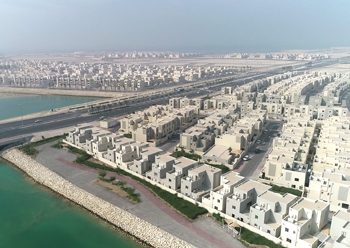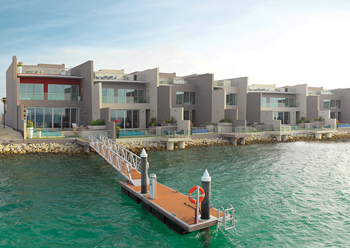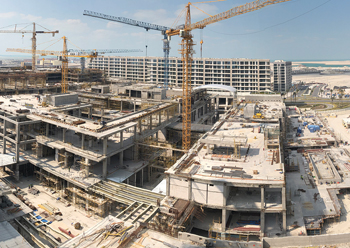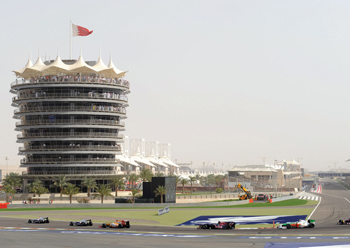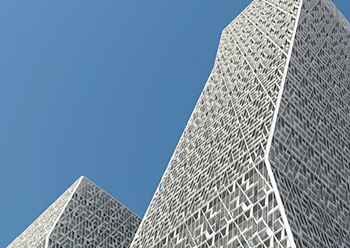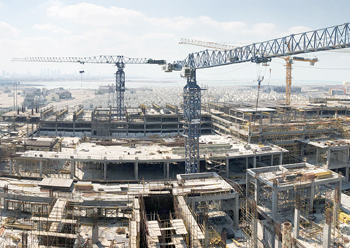
 Marassi Al Bahrain ... a key project taking shape at Diyar Al Muharraq.
Marassi Al Bahrain ... a key project taking shape at Diyar Al Muharraq.
As Bahrain spearheads a drive to vaccinate its citizens and residents against the dreaded coronavirus, the construction industry is optimistically eyeing a steady recovery of the economy and with it the fortunes of the sector.
There is no denying that Covid-19 has totally disrupted life globally. Bahrain, in common with oil-reliant economies, suffered the double whammy of the coronavirus and low oil prices crises. While the country did not have to resort to a total lockdown in response to the pandemic, construction sites with their hundreds of workers had to put in place strict physical/social distancing protocols to meet Covid-19 regulations and minimise health risks as one positive Covid-19 case would put a whole team out of action in isolation for a fortnight. Contractors have also had to bear the additional financial burden of ensuring stringent hygiene standards and social distancing measures on their transportation, labour camps and workplaces.
With land borders closed, imported construction materials initially became unavailable and shipping costs have risen substantially.
 |
|
Onyx Bahrain Bay ... a striking landmark. |
Bahrain’s government has won praise for the unprecedented packages of relief measures worth more than BD4.5 billion ($11.87 billion) it launched to help individuals as well as the corporate sector to offset some of the detrimental impacts of the virus.
In fact, the country appears to be coping better than most people feared. Bahrain’s real GDP (gross domestic product) grew at 1.4 per cent quarter-on-quarter (QoQ), or 10.8 per cent in nominal terms, during the third quarter (Q3) of 2020, recovering in line with the global economy after the contractions over the first half of the year, according to a BNA report.
Major infrastructure projects continued to see progress over Q3 2020, as the value of the funded projects under the GCC Development Fund increased during Q3 2020 by $0.2 billion, with the award of several contracts for the provision of electricity and water services and housing units in Madinat Salman.
Bahrain awarded a total of 1,022 tenders in the first nine months valued at a total of $2.7 billion, according to the country’s Tender Board. In terms of value of contracts, the construction and engineering industry secured 162 tenders worth a combined $704.8 million – clearly underscoring the government’s continued commitment to its extensive pipeline of major infrastructure projects, currently valued at some $32 billion (see Page 6).
That the construction sector hasn’t been severely impacted may be due to the fact that contracts that were awarded have gone ahead, albeit at a slower pace and delays in completion should be expected. However, some in the industry believe that projects on the drawing board have not been pushed forward and the sector could face challenges in the near term.
Others believe that with Bahrain being a small market, all it requires is one mega project to keep the construction sector busy.
 |
|
The fourth Manama-Muharraq Crossing ... dredging works in progress. |
The kingdom’s $32-billion infrastructure project pipeline is a major contributor and driver of national economic growth, according to the Tender Board. The sector’s contribution to the GDP however fell steadily over the first half of the year as would be expected. Trading Economics, an online platform that provides historical data, economic forecasts, news, and trading recommendations, says that GDP from construction in Bahrain is expected to hit BD232.99 million by the end of the fourth quarter, according to its global macro models and analysts’ expectations. Quoting sources from Bahrain’s Ministry of Finance, Trading Economics states that GDP from construction decreased to BD233.89 million in the second quarter of 2020 from BD235.51 million in the first quarter of 2020.
In the long term, the sector’s quarterly contribution is projected to trend at around BD248.94 million in 2021 and BD255.16 million in 2022, according to Trading Economics’ econometric models.
There is reason for optimism with the second phase of Bahrain’s $1.1-billion Airport Modernisation Programme (AMP) now under way. In the industrial sector, work has reached 60 per cent completion on the $6-billion Bapco Modernisation Programme, the biggest project in the kingdom’s history, and is on track for completion by the third quarter of 2022.
A key ongoing project for the MICE (meetings, incentives, conferences and exhibitions) segment is the new BD83.6-million international exhibition and convention centre being built next to the Bahrain International Circuit in Sakhir, work on which is reported to be 14 per cent complete (see Page 7).
The construction sector is waiting with bated breath for the government to flag off this year Bahrain’s ambitious $2-billion metro project, the North Manama Causeway Project (fourth Manama-Muharraq crossing), where dredging and reclamation work is under way, and the second Bahrain-Saudi causeway (the proposed $3.5-billion King Hamad Causeway).
Meanwhile, housing continues to be a major priority for the government, with thousands of homes being completed and new townships being created in Salman City, East Hidd, East Sitra and Khalifa Town. Late last month, Bahrain launched work on the first phase of East Sitra New Town, a mega housing project designed to provide more than 3,000 homes. The project, the first of its kind between the Government of Bahrain and the People’s Republic of China in the residential sector, is being implemented in three phases over 72 months at a total cost of $691 million. To expedite the delivery of homes under HM King Hamad bin Isa Al Khalifa’s plan to build 40,000 housing units for citizens, the Ministry of Housing has turned to the private sector for the construction of homes, with a noteworthy scheme being Mazaya.
Housing
The $241.2-million first phase of the East Sitra New Town, which has just been launched, consists of 1,055 housing units and is scheduled to be completed by January 2023. The project is being undertaken by the Ministry of Housing in partnership with the China Machinery Engineering Corporation (CMEC).
Among other projects, at Madinat Salman, construction of 1,402 apartments is expected to commence this month (January 2021) while the second phase of Khalifa Town, for 372 units, is currently in the final design stage and construction tenders are scheduled to be launched in the second quarter of 2021.
In addition, the ministry has over 5,000 housing units throughout the country in a variety of project sizes in its tendering pipeline (see Page 32).
 |
|
The new terminal which was completed last year at Bahrain International Airport. |
Bahrain Airport
Work is in progress on Phase Two of the Bahrain International Airport expansion, which includes the demolition of certain sections of the old terminal building to facilitate the extension of the new terminal building concourse and works at the landside areas.
In mid-August, Hill International which is providing project management services for the $1.1-billion Airport Modernisation Programme (AMP), managed the handover of the first phase of works. This phase was centred on the construction of a new 210,000-sq-m terminal featuring premium-class check-in halls, check-in desks, passport control booths, E-gates, security lanes, a 9,000-sq-m duty-free retail space, premium-class lounges, food and beverage zones, 24 departure gates, and 7,000 new parking spaces both at-grade and in multi-storey facilities.
While the new terminal was completed last year, the official opening has been pushed back due to the global Covid-19 pandemic. The terminal is four times the size of the existing one and will be able to accommodate 14 million passengers a year.
In addition to the new passenger terminal and related projects such as the central utilities complex, the multi-storey car-park, staff parking area, Super Gate and fire station, the AMP includes several infrastructure development projects. The transfer of operations to the new terminal will be complemented with fuel farm complex operations, including three aviation fuel tanks. The coming months will also see the inauguration of the new private aviation terminal, which will cater to businessmen and private aircraft owners.
 |
|
The proposed metro will cover a total length of 109 km. |
Metro
The construction industry is eagerly awaiting the launch of a global tender for the multi-billion-dollar metro project. The estimated cost for Phase One of this ambitious project is around BD500 million to BD600 million ($1.32 billion to $1.58 billion), the kingdom’s Transportation and Telecommunications Minister Kamal Ahmed was quoted as saying in a report. The overall project is expected to be implemented in four phases, and will feature six lines with electric driverless trains capable of carrying 43,000 passengers per hour to stations spread across the country.
Senior Transportation and Telecommunications Ministry official Hussain Yaqoob revealed at a Muharraq Municipal Council meeting late last year that the first phase of the metro project will focus on a 28.6-km segment out of the total 109-km-long line.
Eventually, the project will feature 20 stations across Bahrain. The rail lines will link into a new King Hamad International Station and join the GCC railway network. Work will start from Bahrain International Airport to the Educational Area in Isa Town covering Salmabad, Juffair, Seef, Bab Al Bahrain Area and Al Farouq Junction.
Yaqoob said the four stations in Muharraq will all be located on the Airport Highway. The main station location at the airport is currently under review with Bahrain Airport Company (BAC).
Roads & Bridges
Leading Dutch dredging group Boskalis Westminster Contracting and its joint venture partner Saudi-based Boskalis Westminster Al Rushaid Company is engaged in the dredging and reclamation work for the North Manama Causeway Phase Two and Busaiteen Package Two.
The North Manama Causeway forms part of the Works Ministry’s strategic plan to improve the existing road network by developing new road corridors. The project encompasses over 21 km of new roads, 11 junctions and a new signature bridge, the fourth Manama-Muharraq Crossing. A large section of the network will be located over the sea, for which land reclamation is required.
Meanwhile, the BD20-million flyover linking the intersection of Shaikh Khalifa Bin Salman Highway and Shaikh Isa Bin Salman Highway has been opened. Known as the Saar Intersection, it is a major crossing point for traffic coming via the King Fahad Causeway and Manama.The Works, Municipalities Affairs and Urban Planning Ministry said the project, which includes a uni-directional left turn flyover, serving the same traffic movement, and the expansion of the Shaikh Khalifa Bin Salman Highway, will tackle traffic congestion witnessed on both highways at rush hours and increase their capacity.
Power & Water
Work is in progress on the second phase of the Al-Dur Power and Water Plant, an independent water and power project (IWPP) which will have a production capacity of 1,500 MW of electricity and 50 million gallons per day of drinking water. The plant is expected to come on line in summer 2021, increasing Bahrain’s capacity to 5,420 MW of electric power and 236 million gallons per day of desalinated water.
The project is being supervised by the Electricity and Water Authority (EWA) which has launched a drive to utilise solar energy in operating water pumping and distribution stations. The EWA recently saw the completion of the Al-Seef Water Transfer and Distribution Station, which is considered the first of the EWA stations to be supplied with clean electrical energy produced from solar panels installed on the facades and roofs of the buildings of this station. The strategy is now being implemented at Juffair and Nabih Saleh water distribution stations and will be applied to all future stations.
In line with the EWA’s water strategy to increase the storage capacity to ensure a strategic stock for three days in excess of 550 million gallons per day, the authority recently saw the completion of Khalifa bin Salman Port Water Distribution Station in the Hidd Industrial Area, as part of the first stage of the water transmission network development project.
Real Estate
In the real estate sector, the two focal areas that have seen much development over the past year are Diyar Al Muharraq – one of the largest integrated cities in the kingdom – and its component Marassi Al Bahrain off Muharraq (see Page 35); and Bahrain Bay in the heart of the capital Manama, which will host the Onyx Bahrain Bay tower.
Onyx Bahrain Bay is being developed by Kooheji Development. It offers a variety of one- to 3.5-bedroom apartments and four- and five-bedroom sky villas, and is claimed to host the largest penthouses in Bahrain Bay.
Major developments are also under way at Bahrain’s health and wellness island Dilmunia, which has recently seen the completion of its mall as well as the Grand Canal and is now looking at building a mosque, which is being designed by MSCEB Architects & Engineers.
Despite the pandemic, work has just been launched on the striking Future Generation Reserve Tower strategically located overlooking the Bahrain Financial Harbour and Bahrain Bay. It is set to the kingdom’s first investment tower to be Leed (Leadership in Energy and Environmental Design) certified. Another architectural marvel taking shape is the 41-storey Spiral Orchid Residence in Water Garden City in Seef District.
Meanwhile, Edamah, the real estate unit of the kingdom’s sovereign wealth fund Mumtalakat, has been spearheading a number of projects such as its premium mixed-use project, Sa’ada, located in Muharraq, and Bilaj Aljazayer, a seafront mixed-use tourism and recreational development on the southwestern coast of Bahrain.
Edamah says it has invested BD7 million on Phase One of Sa’ada, which will boast multi-purpose commercial outlets, restaurants, entertainment halls, sports halls, a park and public spaces on a total area of more than 13,000 sq m. Work is now under way on the second phase of Sa’ada.
Among other developers, Seef Properties is developing the mixed-use Al Liwan project, which is nearing completion in Al Hamala. Al Liwan will boast a combination of commercial, entertainment, and housing facilities. It also includes a state-of-the-art cinema theatre, a family entertainment centre as well as open areas and boulevards.
Other projects
The Works, Municipalities Affairs and Urban Planning Ministry is supervising work on a multi-million-dinar headquarters of the Transportation and Telecommunications Ministry. The seven-storey building is being developed on a 15,611-sq-m plot of land in Muharraq with overall construction covering 19,275 sq m.





















_0001.jpg)


.jpg)
















.jpg)








.jpg)



